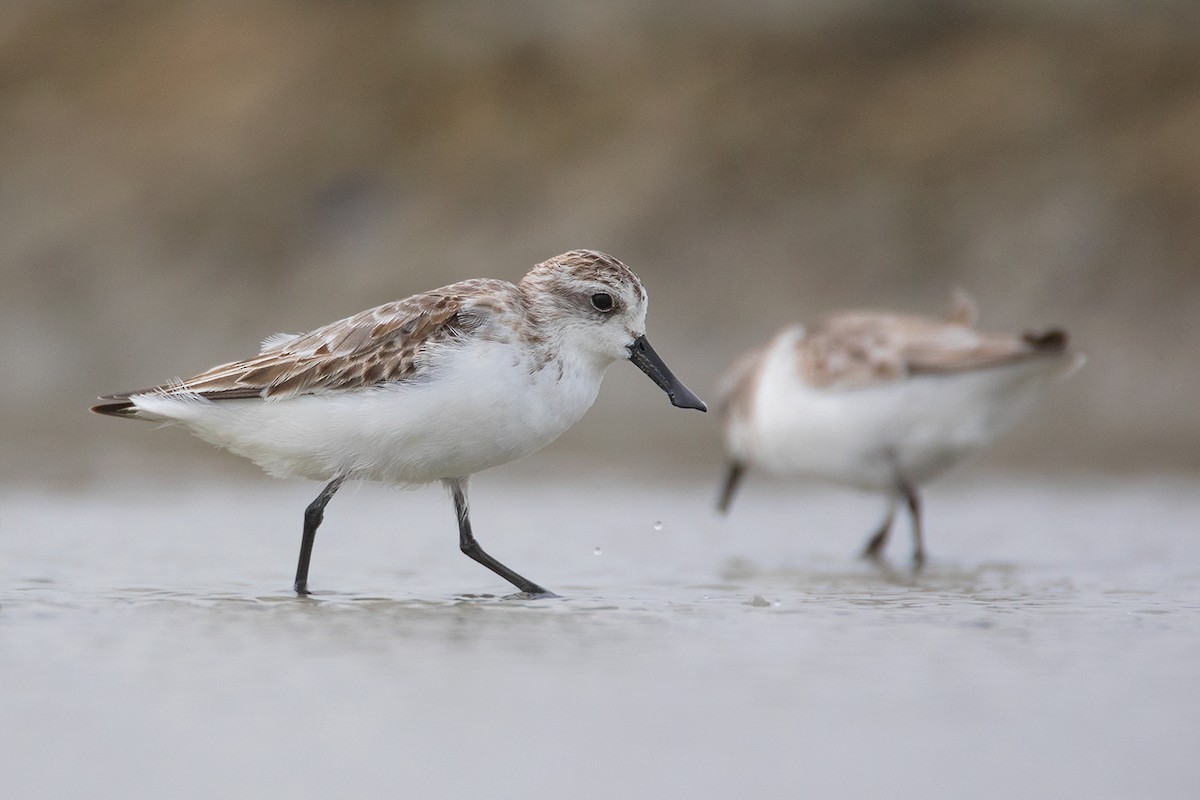Spoon-billed Sandpiper
A species of Spoonbill sandpipers Scientific name : Calidris pygmaea Genus : Spoonbill sandpipers
Spoon-billed Sandpiper, A species of Spoonbill sandpipers
Botanical name: Calidris pygmaea
Genus: Spoonbill sandpipers
Content
Description General Info
 Photo By Ayuwat Jearwattanakanok
Photo By Ayuwat Jearwattanakanok Description
The most distinctive feature of this species is its spatulate bill. The breeding adult bird is 14–16 cm in length, and has a red-brown head, neck and breast with dark brown streaks. It has blackish upperparts with buff and pale rufous fringing. Non-breeding adults lack the reddish colouration, but have pale brownish-grey upperparts with whitish fringing to the wing-coverts. The underparts are white and the legs are black. The measurements are; wing 98–106 mm, bill 19–24 mm, bill tip breadth 10–12 mm, tarsus 19–22 mm and tail 37–39 mm. The contact calls of the spoon-billed sandpiper include a quiet preep or a shrill wheer. The song, given during display, is an intermittent buzzing and descending trill preer-prr-prr. The display flight of the male includes brief hovers, circling and rapid diving while singing. 
Size
16 cm
Life Expectancy
16 years
Nest Placement
Ground
Feeding Habits
Spoon-billed Sandpiper consumes moss, insects like mosquitoes, flies, beetles, spiders, and marine life including shrimp and worms. It forages by probing with its spoon-shaped bill, specializing in soft muddy areas, displaying unique adaptions for extracting prey.
Habitat
Sea coasts and adjacent hinterland on the Chukchi Peninsula and southwards along the isthmus of the Kamchatka Peninsula, coastal areas in the tundra, locations with grass close to freshwater pools
Dite type
Aquatic invertebrate eater
General Info
Feeding Habits
Bird food type
Behavior
Its feeding style consists of a side-to-side movement of the bill as the bird walks forward with its head down. This species nests in June–July on coastal areas in the tundra, choosing locations with grass close to freshwater pools. Spoon-billed sandpipers feed on the moss in tundras, as well as smaller animal species like mosquitoes, flies, beetles, and spiders. At certain points in time, they also feed on marine vertebrates such as shrimp and worms. 
Distribution Area
The spoon-billed sandpiper's breeding habitat is sea coasts and adjacent hinterland on the Chukchi Peninsula and southwards along the isthmus of the Kamchatka Peninsula. It migrates down the Pacific coast through Japan, Korea and China, to its main wintering grounds in south and southeast Asia, where it has been recorded from India, Bangladesh, Sri Lanka, Burma, Thailand, Vietnam, the Philippines, Peninsular Malaysia and Singapore. Through phylogenetic analyses for the complete mitogenome sequence, South Korean and Chinese C. pygmaea groups were indicated to be closely related to Arenaria interpres because of the similarity in the series of protein-coding genes. 
Species Status
This bird is critically endangered, with a current population of fewer than 2500 – probably fewer than 1000 – mature individuals. The main threats to its survival are habitat loss on its breeding grounds and loss of tidal flats through its migratory and wintering range. The important staging area at Saemangeum, South Korea, has already been partially reclaimed, and the remaining wetlands are under serious threat of reclamation in the near future. Long-term remote sensing studies have shown that up to 65% of key spoon-billed sandpiper habitat in China, South Korea and North Korea has been destroyed by reclamation. A 2010 study suggests that hunting in Burma by traditional bird trappers is a primary cause of the decline. Protected areas in its staging and wintering areas include Yancheng in China, Mai Po Marshes in Hong Kong and Point Calimere and Chilka lake in India,. As of 2016, the global spoon-billed sandpiper population was estimated at 240–456 mature individuals or at maximum 228 pairs. Formerly classified as an Endangered species by the IUCN, recent research shows that its numbers are decreasing more and more rapidly and that it is on the verge of extinction. It is consequently reclassified to Critically Endangered status in 2008. The population was estimated at only 120–200 pairs in 2009–2010, perhaps indicating an 88% decline since 2002 equating to an annual rate of decline of 26%. Draining of the Saemangeum estuary in South Korea removed an important migration staging point, and hunting on the important wintering grounds in Burma has emerged as a serious threat. This species may become extinct in 10–20 years. In November 2011, thirteen spoon-billed sandpipers arrived at the Wildfowl and Wetlands Trust (WWT) reserve in Slimbridge, Gloucestershire, United Kingdom to start a breeding programme. The birds hatched from eggs collected in remote northeastern Russian tundra earlier and spent 60 days in Moscow Zoo in quarantine in preparation for the 8,000 km journey. Artificial incubation and captive rearing, termed headstarting, were expected to increase survival rates from less than 25% to over 75%, and the removal of eggs was expected to lead to a second clutch reared by the parents. In 2019, almost a decade since the rescue mission, the two birds were first to be born in a UK spoon-billed sandpiper ark. In 2013, conservationists hatched twenty chicks in Chukotka. 

 Photo By Ayuwat Jearwattanakanok
Photo By Ayuwat Jearwattanakanok Scientific Classification
Phylum
Chordates Class
Birds Order
Shorebirds Family
Sandpipers Genus
Spoonbill sandpipers Species
Spoon-billed Sandpiper